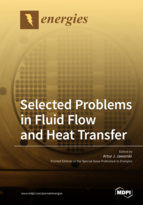Fluid Flow and Heat Transfer
A special issue of Energies (ISSN 1996-1073). This special issue belongs to the section "F: Electrical Engineering".
Deadline for manuscript submissions: closed (31 March 2019) | Viewed by 111109
Special Issue Editor
Interests: energy; heat transfer; thermodynamics; thermoacoustics; fluids; aerodynamics; multiphase flow; process tomography; sensors and instrumentation; heterogeneous mixtures; microfluidics; nanofluids
Special Issues, Collections and Topics in MDPI journals
Special Issue Information
Dear Colleagues,
I would like to extend a warm invitation to all colleagues who would like to submit their research papers to the Special Issue of Energies (ISSN 1996-1073; CODEN: ENERGA) on "Fluid Flow and Heat Transfer". This is a topical issue dedicated to the recent advances in this very broad field—the main criteria for paper acceptance being academic excellence, originality and novelty of applications, methods or fundamental findings. All types of research approaches are equally acceptable: experimental, theoretical, computational, and their mixtures; the papers can be both of fundamental or applied nature, including industrial case studies. With such a wide brief, it is naturally very difficult to define a finite list of relevant disciplines. However, it is broadly anticipated that the authorship and ultimate readership would come from the fields of mechanical, aerospace, chemical, process and petroleum, energy, earth, civil and flow instrumentation engineering, but equally biological and medical sciences, as well as physics and mathematics—that is everywhere where “fluid flow and heat transfer” phenomena may play an important role or be a subject of worthy research pursuits. Cross-disciplinary research and development studies will also be most welcomed.
Prof. Dr. Artur J. Jaworski
Guest Editor
Manuscript Submission Information
Manuscripts should be submitted online at www.mdpi.com by registering and logging in to this website. Once you are registered, click here to go to the submission form. Manuscripts can be submitted until the deadline. All submissions that pass pre-check are peer-reviewed. Accepted papers will be published continuously in the journal (as soon as accepted) and will be listed together on the special issue website. Research articles, review articles as well as short communications are invited. For planned papers, a title and short abstract (about 100 words) can be sent to the Editorial Office for announcement on this website.
Submitted manuscripts should not have been published previously, nor be under consideration for publication elsewhere (except conference proceedings papers). All manuscripts are thoroughly refereed through a single-blind peer-review process. A guide for authors and other relevant information for submission of manuscripts is available on the Instructions for Authors page. Energies is an international peer-reviewed open access semimonthly journal published by MDPI.
Please visit the Instructions for Authors page before submitting a manuscript. The Article Processing Charge (APC) for publication in this open access journal is 2600 CHF (Swiss Francs). Submitted papers should be well formatted and use good English. Authors may use MDPI's English editing service prior to publication or during author revisions.
Keywords
- fluid mechanics
- heat transfer
- thermo-fluids
- thermodynamics
- theoretical
- numerical
- experimental
- fundamental
- applied






